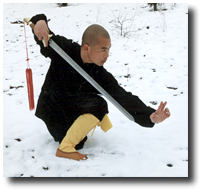The Kung Fu of five Ancient systems
By Harlan Lee
Sil Lum Fut Ga Kuen is a style of kung fu developed during the time China's Ming Dynasty, which ruled during the 17th century. The art was founded and developed by a Buddhist monk using techniques from the five great masters of the Shalin temple: Lau, Lee, Mok, Hung, and Choy.
Unlike many other martial arts forms, Shaolin kung fu origins are based in religion. The Shaolin Temple was founded as a part of the Chan Sect, a school of Buddhism adapted to the Chinese culture during the early sixth century. The Chan Sect soon became the dominant Buddhist school in china, with more than 79 percent of the country's temples practicing its teachings. Two Shaolin temples were built, one for the northern sect and one for the southern. These Shaolin Temples distinguished themselves from the others in that their monks were martial arts experts. Throughout history, and still today, the life of a Shaolin monk is dedicated to studying and living the scriptures of Buddhism, and to intense martial arts training.
The geographical locations of the temples combined with Chinese history led to the emphasis on martial arts within the Shaolin lifestyle. Chinese history is one of numerous wars and power struggles between regions and rulers. The Shaolin temples, located in the center of the country, served as refuges for many soldiers, dissidents, and persons fleeing persecution. Several of these refugees were recognized martial arts experts, and their combined presence at the temple allowed for the exchange of different wushu styles and techniques. This helped to refine and improve the techniques being taught to the monks. The monks, in turn, fused these techniques with their system of meditation and qugong. Martial arts training also had a practical importance, as the temples needed to be protected from marauders and pillagers.
Chinese, and it was generally believed that hand techniques were a more effective way of fighting for a shorter person. The southern style also stressed a strong, firm stance as a base for generating powerful hand techniques, and movements that are simpler and more direct.
Fusion of styles
The Five Great Masters of Shaolin developed the basic wushu styles taught to early Saholin monks. Each style had unique techniques and emphasized elements. For example, Hung Ga emphasized brute strength and a low. Wide stance; Mok Ga was famed for its kicks; and Lau Ga was known for its locking hand techniques.
 In the mid-1600s, a Shaolin disciple proficient in all five styles sought to create a new form incorporating only best elements from each of them. He was also influenced by a number of gifted Chinese boxers seeking refuge at the temple. In creating this new martial art form, he kept only the techniques he felt were most efficient and discarded those he considered less essential. The final result became Sil Lum Fut Ga Kuen, meaning Shaolin Buddhist Family fist. This form contains techniques form both northern and southern kung fu styles, and from all five of the Great Masters.
In the mid-1600s, a Shaolin disciple proficient in all five styles sought to create a new form incorporating only best elements from each of them. He was also influenced by a number of gifted Chinese boxers seeking refuge at the temple. In creating this new martial art form, he kept only the techniques he felt were most efficient and discarded those he considered less essential. The final result became Sil Lum Fut Ga Kuen, meaning Shaolin Buddhist Family fist. This form contains techniques form both northern and southern kung fu styles, and from all five of the Great Masters.
Fut Ga Kuen's fundamental principle is based on the idea that one's ultimate striking power is generated by the velocity of the blow and the practitioner's ma bu or foundation. With a solid foundation, the Fu Ga Kuen practitioner, through his horse stance, produces the highest degree of force behind every block or strike. In addition, the efficient techniques are designed to stress speed and quickness in the execution of each individual move. The combination of optimum force and velocity creates this ultimate power.
Modern Expansion
The art of
Sil Lum Fat Ga Kuen was taught only within China for nearly 300 years after its creation. In 1933, Sun Kung Sifu Lum Dai Yong of northern china accepted an invitation to tech students at the first Chinese martial arts school ever located outside the country. The school. Jimg Moo Chinese Physical culture Association, had been established in Honolulu, Hawaii, earlier that year. It was here that this style of Fut Ga was first introduced outside of its native land.
Born in 1895, Lum Dai Yong was a Daoist priest raised and educated in the Shaolin monastery where his father taught and resided. Although only five-feet-nine and 135 pounds, he became an expert martial artist, skilled enough to be a personal bodyguard for the Chinese revolutionary Sun Yat Sen. He was also well-versed in the growing and use of Chinese herbs in spiritual and medical healing. In 1941, Professor Lum opened his own martial arts school, naming the Gee Yung ("Go forth: be courageous") Chinese Physical culture Association, which taught the Fut Ga style exclusively.
One of Lum Sifu's students joined Jing Moo in 1937. Although a severe asthmatic, lacking in self-esteem, seven-year-old Arthur lee would become Professor Lum's prize pupil. Upon Lum Sifu's death in 1957, the Gee Yung Chinese Physical Culture Association was passed on to Sifu Lee, who heads the club today.
Continuing the Style
Throughout his career as grandmaster and head instructor of Gee Yung, Sifu Lee has always perpetuated the fut Ga art through widespread exposure and instruction. Sifu Lee was the first Chinese martial arts instructor in Hawaii to open his school to students of non-Chinese ancestry. Martial arts forms cannot be simply handed from one person to another. They can only be passed on to new generations through years of supervision and training.
 Sifu Lee has continued to espouse the theories of Fut Ga learned from Professor Lum. For example, one major distinction between Fut Ga and other kung fu styles is the huang ma, or walking horse training. Most kung fu styles stress the paang ma theory of training - a level horse stance used to develop leg strength and power. Sifu Lee teaches his students this stance as part of their training routine, but puts more emphasis on moving and shifting stances while maintaining balance and solidity. Learning to shift quickly and smoothly results in faster execution and movement.
Sifu Lee has continued to espouse the theories of Fut Ga learned from Professor Lum. For example, one major distinction between Fut Ga and other kung fu styles is the huang ma, or walking horse training. Most kung fu styles stress the paang ma theory of training - a level horse stance used to develop leg strength and power. Sifu Lee teaches his students this stance as part of their training routine, but puts more emphasis on moving and shifting stances while maintaining balance and solidity. Learning to shift quickly and smoothly results in faster execution and movement.
Faster execution leads into a second tenet of Fut Ga, the theory of "touch-go." Combinations of blocks and counter-strikes are not done in individual steps, but in one spontaneous movement. The block and strike are executed simultaneously, as are following combinations of blow and kicks. Fu Ga also teaches to strike in threes - to not be satisfied with one hit, but to follow up with at least two more strikes. Combinations of blocks and strikes require many weight shifts; the emphasis on speed in execution demands that the student subtly and effortlessly move from one stance to another.
Students spend many class hours training to increase the speed of their hand and kicking techniques. The importance of the walking horse training method is how it develops the speed of shifting the practitioner's stance to match the increased speed of hand and leg movements acquired through training. As noted previously, Fut Ga power is generated through velocity of technique and maintaining the foundation. Therefore, to acquire optimum force behind every move, students must be able to shift stances as quickly as they execute techniques. As the hands and legs become faster, so must the ability to balance and "plant' the foundation.
Fut Ga's defining characteristic - reflected in its blocks, punches, and kicks - it its simplicity. A major element of speed is traveling the shortest distance between two points. In addition to being the fastest way to travel, the shortest way is also the most efficient tool.
Sifu Arthur Lee is part of a continuing legacy of Sil Lum Fut Ga Kuen. The history and tradition of this martial art date back hundreds of years, and in many ways reflect the history of Chinese culture itself. Sifu Lee feels that it is his responsibility to continue this legacy by instructing and spreading Sil Lum fut Ga Kuen to new generations of practitioners. In order to do so, there must be a continuing pool of dedicated students seeking to become a part of Fut Ga's history. Sifu Lee has always taught his students that no martial art form, including Fut Ga, is better than any other. Instead, it is the amount of effort and willingness to train and sacrifice that improves the individual, and expands the limits of achievement. Kung fu is a tool that can enhance this self-development. In this way, says Sifu lee, "Kung fu is not just learning how to fight. Kung fu is life."
Click here for Feature Articles from this issue and others published in
1995 .
Written by Harlan Lee for KUNGFUMAGAZINE.COM
![]() Print Friendly Version of This Article
Print Friendly Version of This Article















